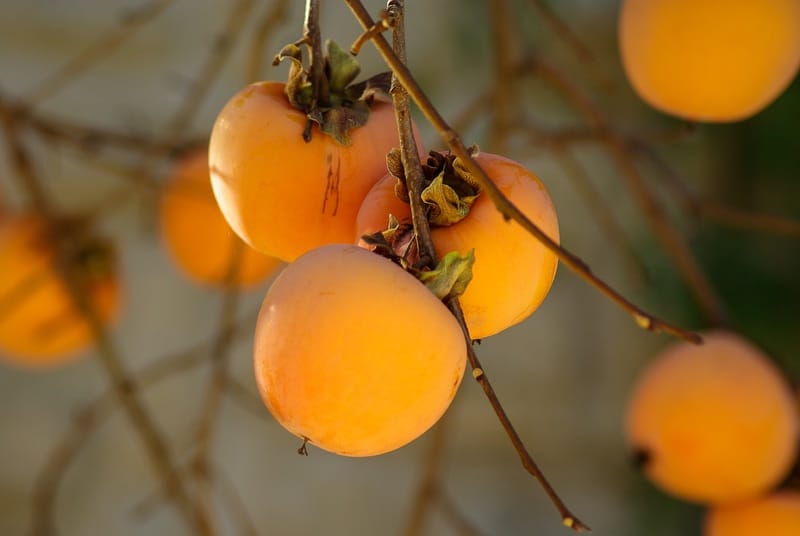Wondering how to prune persimmons? The delicious fruits and its beautiful trees are the reason why many people are interested in growing persimmon trees in their yards.
Persimmons are known for their sugary and honey-like flavor and can be eaten fresh, dried, or incorporated in many desserts around the world. It’s essential to learn how to prune Persimmons effectively to develop a strong frame for the tree.

Pruning is the practice of cutting away frail, unhealthy, or deceased limbs of the tree. The main purpose of pruning is to improve its form, boost growth, and diminish the danger of spreading disease. It keeps also your trees healthy and it helps encourage fruit production.
Prune Persimmons: Practical Guidelines
Pruning Persimmons should be done at least once a year during winter. This is because the sap is normally dormant during these times. Make sure to remove excess growth, any deceased or poorly positioned wood, and unwanted branches.
Here are some easy tips to successfully prune your Persimmons:
Tip #1. Choose the right timing
It is crucial to choose the right time when to prune Persimmons because this will greatly affect the tree. For best results, prune your persimmon trees in the early spring or late in the winter when it is in its dormant state. This will help protect the tree’s fruit-bearing ability.
It’s also important to prune the branches of the Persimmon during the fruiting season as this can help encourage the production of more fruits. Ideally, pruning should be done yearly to remove new growth and tops of the tree’s branches.
Tip #2. Sharpen and clean your tools
It is important to gather the right tools for pruning. The tools needed are the bypass shears and pruning loppers. These are usually available in gardening supply stores and online.
When sharpening the correct tools, it’s important to proceed with caution to avoid injuries. Make sure that the tools are evenly sharpened so the branches are cut cleanly and the tissues of the plants won’t be damaged. Be sure to use clean tools to avoid pathogens from infecting the delicate tissues of the tree.
Tip #3. Complete corrective pruning & trimming
Corrective pruning is the process of removing dying branches. Removing the dead weight will help to ensure the shape of the tree. It is also important to focus on the rest of the tree by cutting the length of each branch by one-third which will help the growth of the Persimmon tree.
While pruning, be sure to work on the crowded branches of the Persimmon trees, as well. Overcrowded crowns will block sunlight, thus hindering the growth of the tree. Trim the tree every now and then to maintain its pleasing shape.
Tip #4. Train your persimmons
Train your tree to grow into the shape you desire. Its growth can be dictated in the right direction. It is better to take some time to learn about growth systems to train Persimmon trees.
One way of doing this is to use frame trellis to support and train some of the branches. Plant the persimmon tree approximately six to ten inches from the fence. You can also use a central leader for training, but in this situation, the tree could grow taller than anticipated.
Tip #5. Choose the right environment
Persimmon trees grow best in deserted places. This means that there should be no other plant grown near it because this will cause competition for nutrients. This type of tree needs all the nutrients it can get to produce fresh, abundant fruits.
Persimmons are a cold-weather plant and it grows best in colder temperatures. It can tolerate temperatures below to -25℉.
Tip #6. Use some fertilizers
Healthy soil will determine the growth of the tree and its fruits which is why it’s important to feed the soil now and then with balanced fertilizers (10-10-10). You can either make this at home or buy one at your local nursery or supermarket.
Growing Persimmons Inside a Semi Pro Greenhouse
Pruning Persimmons could be tricky without the right environment and tools. But with semi pro greenhouses, care for Persimmon trees will be much more convenient because of the general condition of the environment. Aside from that, here are two of the biggest benefits of using a semi pro greenhouse to cultivate your Persimmon trees:
Weather protection
One of the greatest benefits of having a semi pro greenhouse is that you’ll get to protect your fragile persimmon saplings from the extreme weather. Whether strong winds are coming or heavy rainfall is about to land, placing your saplings inside the semi pro greenhouse will protect them from the dangers of floodwaters.
Pest protection
With the enclosure that semi pro greenhouses provide, you will be assured that your young persimmon plant will be protected from any pests and diseases. With the semi pro greenhouse covered with fiberglass or durable plastic films, lesser pests will be able to penetrate the enclosure.
How to Prune Persimmons: Final Words
It is important to be mindful and committed to pruning Persimmons. With the right tools, information, and willingness, harvesting the fruit would feel like a reward. Easy and practical ways of pruning Persimmons is the way to go.
It is important to learn how to prune Persimmons because this will aid in the growth of the tree. It will be aesthetically pleasing and the fruits would be much tastier when pruned.

A tree removal company should have the proper equipment for taking care of dead trees. They also should know how to handle power lines and any other utility lines that might be necessary to bring the dead trees down. They will also help you with the papers needed. Message cheyennetreeservices.com